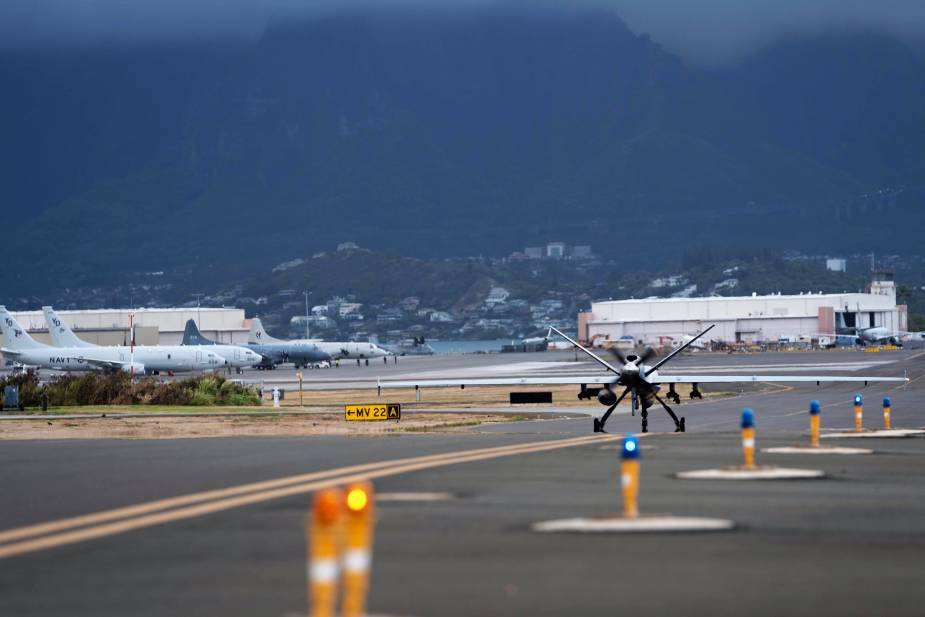Breaking news
MQ-9A Reaper UAV makes its debut at RIMPAC SINKEX 2022.
The first-ever use of a U.S. Air Force MQ-9A Reaper, a remotely piloted aircraft, during a Rim of the Pacific (RIMPAC) 2022 sinking exercise (SINKEX), July 12. Airman 1st Class Ariel O’Shea reports on navy.mil.
Follow Air Recognition on Google News at this link
 The presence of the MQ-9A Reaper at the world’s largest international maritime exercise provides an opportunity for combined and joint-force collaboration. (Picture source: U.S. Navy)
The presence of the MQ-9A Reaper at the world’s largest international maritime exercise provides an opportunity for combined and joint-force collaboration. (Picture source: U.S. Navy)
Participating in the SINKEX provided an opportunity for units from Australia, Canada, Malaysia and the U.S. to test weapons and systems in a simulated environment, working against opposing forces and eventually culminating in the explosion of a decommissioned naval vessel and marked a significant development in maritime warfighting capability.
The presence of the MQ-9A’s at the world’s largest international maritime exercise provides an opportunity for combined and joint-force collaboration. “They need us and we need them,” said U.S. Air National Guard Capt. Phillip West, the RIMPAC MQ-9 maritime force integration lead. “That's where RIMPAC comes into play.”
He said the Air Force and the Navy speak different languages, each using their own distinct jargon. Working together on exercises like RIMPAC and the SINKEX promotes smooth communication between the branches. This ensures sharpened combat readiness, increased strategic impact, and strengthened deterrence efforts by providing tactical proficiency to MQ-9A aircrews.
“Participation in the RIMPAC exercise is helping us evolve,” said Col. Steven Beattie, 49th Operations Group commander. “We’re developing maritime and Pacific (area of responsibility) expertise for our aircrew, maintenance, and support personnel.”
With the MQ-9 flying over the ocean as opposed to routine training in remote land locations, the main objective for the SINKEX was the gathering of practical data about operating in a maritime environment as opposed to a desert environment.
“The data that we have in a simulator feeds off of real-world engagements like SINKEX,” West said. “With what’s called the new Smart Sensor, they're trying to build a database of what ships look like. They need us to actually do it so that they can build a database, and then they can fit it into a simulator so we can practice it and have more efficient training.”
The SINKEX is one of the many unique training opportunities RIMPAC provides to the U.S. military, its allies, and partner nations. With it, we can foster and sustain cooperative relationships that are critical to ensuring the safety of sea lanes and security on the world’s interconnected oceans.
This year is historic not only because of the MQ-9A but because it marks a return to a full-scale exercise not seen since before the COVID-19 pandemic. The 2020 iteration of RIMPAC was reduced in scale to be conducted with less face-to-face contact. The return to a full-scale exercise demonstrates capable, adaptive partners working together to increase the interoperability, resiliency, and agility needed by the joint and combined force.
Twenty-six nations, 38 ships, four submarines, more than 170 aircraft and 25,000 personnel are participating in RIMPAC from June 29 to Aug. 4 in and around the Hawaiian Islands and Southern California. The world's largest international maritime exercise, RIMPAC provides a unique training opportunity while fostering and sustaining cooperative relationships among participants critical to ensuring the safety of sea lanes and security on the world's oceans. RIMPAC 2022 is the 28th exercise in the series that began in 1971.



















